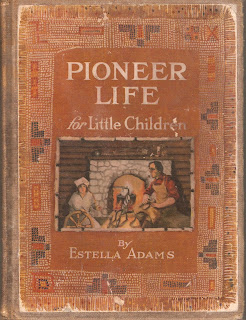She likely wrote the book while living in her beautiful new home at 440 North Irvington Avenue. She resided there with her mother, Margaret, and her brother, George. City records indicate that Miss Adams took out a building permit in 1911 for the property. It is unknown how she was able to afford such a grand home, but the Indianapolis News in 1905 published that she had invested $200 in the Citizens Gas Company so perhaps she had earned a comfortable living with some shrewd investments.
Pioneer Life was illustrated by Harrison Fisher and Marie Stewart. In the first third of the book, Miss Adams wrote about the lives of the Indians who lived in the Midwest. The illustrations in this part of the book are realistic and somewhat romanticized. Her treatment of the native peoples is much more respectful than many narratives of her day. The illustrator of this section chose to draw images of the Plains Indians and not those who actually dwelled in Indiana. In the second third of the work, Miss Adams described life for the white people who moved into the area. Like most children's histories, this section is sanitized. The Indians, according to the author, moved away because the deer and the bison were no longer as plentiful. How does one tell first graders that their ancestors actually forced the native peoples from their land and on to reservations? The illustrations in this section are more like etchings. She does challenge the children to think about the lives of the two groups.
Indian girls carry wood for the fire.
They string red and yellow beads.
They make pretty baskets.
The baskets are made of sweet grasses.
The girls make bowls of clay.
They paint the bowls after they are dry.
They carry water in these bowls.
Can you make a clay bowl?
 |
| Pioneer Life for Little Children appeared in print on August 6, 1916, and was used throughout the state of Indiana. |
 |
| Estella Adams, who taught at School #57, dedicated the book to the neighborhood children. |
Miss Adams dedicated the book to the children of Irvington. She and her family continued to dwell in their Irvington Avenue home until 1919. For unknown reasons, she took a leave of absence from the Indianapolis Public Schools and eventually moved to California. The Rush family purchased her house.
Sources: "Recent Publications," Indianapolis Star, August 6, 1916, 6; "Written Book on Pioneer Life," Indianapolis News, December 7, 1916, 13; Obituary for Margaret Adams, Indianapolis Star, July 8, 1933, 10.




Loved the story of the Muslin on windows during winter. Wonder if any parents complained ?
ReplyDeleteI wondered the same thing!!
ReplyDelete